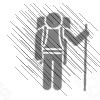 It’s not spring yet, and surely we’ll have more winter weather before spring becomes our official season… right?! Moreover, we love winter here at Redline Guiding and dislike having to even talk about spring yet. That said, looking outside, feeling the temperatures, seeing the damage rains have done, and listening to the drip-drip-drip of meltwater, forces us to consider it. And with this consideration, here is an article meant to inform and raise awareness of spring in the mountains. It’s an article that all too suddenly seems timely… as if it were April.
It’s not spring yet, and surely we’ll have more winter weather before spring becomes our official season… right?! Moreover, we love winter here at Redline Guiding and dislike having to even talk about spring yet. That said, looking outside, feeling the temperatures, seeing the damage rains have done, and listening to the drip-drip-drip of meltwater, forces us to consider it. And with this consideration, here is an article meant to inform and raise awareness of spring in the mountains. It’s an article that all too suddenly seems timely… as if it were April.
(This article has been rewritten and improved from an earlier work.)
1. Icy Trails
 The problem: Couple a season of fairly thin snow cover, active ice floes, and high traffic, and you’ll find trails with lots of ice. It’s formed by naturally occurring ice, packed snow, and repeated freeze/thaw cycles.
The problem: Couple a season of fairly thin snow cover, active ice floes, and high traffic, and you’ll find trails with lots of ice. It’s formed by naturally occurring ice, packed snow, and repeated freeze/thaw cycles.
The solution: To deal with the ice there are a number of things hikers can do such as wear traction like Microspikes or crampons — which depends on the terrain and the extent of the ice — pay better attention and tread with greater care, slow down a bit, and use trekking poles to add hand support. It’s also possible, in the worst places, to use a rope as a handrail (for descent).
2. Sliding Falls
 The problem: Long, sliding falls are possible in steep terrain when there is hard packed snow or ice underfoot. These falls can lead to serious injury thanks to the thinning snowpack, exposing rocks in the fall line. Moreover, one can impact trees and other hazards.
The problem: Long, sliding falls are possible in steep terrain when there is hard packed snow or ice underfoot. These falls can lead to serious injury thanks to the thinning snowpack, exposing rocks in the fall line. Moreover, one can impact trees and other hazards.
The solution: To deal with this there are many options. First one can simply stay out of such terrain or choose a clear fall line. One can also be ready to self-arrest a fall, which in hard packed snow (not ice) can be done with a whippet or ice axe and knowing how to use it. Another option is to travel (especially when skiing) during the warmer parts of the day when the snowpack is softer. But do watch out for ice/rock fall during this time. Lastly, stablize yourself with trekking poles and careful footing and treat said terrain as a “no fall zone.” Proper use of crampons, choreographed with an ice axe, can be solid protection in of itself.
3. Thin Ice
 The problem: Sometimes there’s too much ice, and during other times there’s too little. River and pond crossings that were once supported by thick ice as strong as concrete are melting out, breaking, collapsing, getting mushy, being undermined, and are generally no longer trustworthy.
The problem: Sometimes there’s too much ice, and during other times there’s too little. River and pond crossings that were once supported by thick ice as strong as concrete are melting out, breaking, collapsing, getting mushy, being undermined, and are generally no longer trustworthy.
The solution: To deal with this hazard go around bodies of water and treat all crossings carefully being sure to stay on rocks or other supported structures where not crossing isn’t an option. Also, test ice with your trekking poles to reveal weak, thin, soft, or hollow-sounding ice. Snowshoes and skis help by distributing your weight.
4. Entrapment
 The problem: Softening snow bridges and ice can break or collapse causing one to become entrapped in hidden voids alongside boulders, under coniferous trees, in bodies of water, or held by the current trapped under river ice (more-than-likely a briefly terrifying, fatal experience).
The problem: Softening snow bridges and ice can break or collapse causing one to become entrapped in hidden voids alongside boulders, under coniferous trees, in bodies of water, or held by the current trapped under river ice (more-than-likely a briefly terrifying, fatal experience).
The solution: Be aware. Watch where you step. Know these dangers exist. And if at all possible, travel with others. While this solution may seem over-simplified, awareness and maintaining focus can be a challenge.
5. Rising Waters
 The problem: Snow melt and rains will both conspire to drown your spring hiking fun. As the days heats, even without spring showers, water levels can rise during the day making once-possible crossings unsafe (consider any moving water over knee depth unsafe).
The problem: Snow melt and rains will both conspire to drown your spring hiking fun. As the days heats, even without spring showers, water levels can rise during the day making once-possible crossings unsafe (consider any moving water over knee depth unsafe).
The solution: Plan your hikes so that obligatory river crossings are done at the beginning of rainy or particularly warm days and be sure you have a drier alternative for your return route. If an out-and-back is necessary, choose a cooler day when rain isn’t likely to limit the amount water levels rise throughout the day.
6. Ice/Rock Fall
 The problem: It’s time to be especially wary of that which is above you. Old ice floes, for example, are now being separated from their underlying anchors of rock and earth by runnels of water. The attachments fail at this time of year — especially later in the day — and the ice falls. Rock, loosened by ice over the winter, may also fall.
The problem: It’s time to be especially wary of that which is above you. Old ice floes, for example, are now being separated from their underlying anchors of rock and earth by runnels of water. The attachments fail at this time of year — especially later in the day — and the ice falls. Rock, loosened by ice over the winter, may also fall.
The solution: To deal with rock and ice fall, aside by being super vigilant, stay out of the hazard areas where rock and ice looms above. If these areas are unavoidable, be sure to travel in them very early in the day; it’s colder and everything is more stable. Also be sure to travel through them quickly. It’s no time to dawdle, break, and have a photoshoot. Oh, and wear a helmet.
7. Weather
 The problem: Sure, it’s sixty-five in town, fifty-five at the trailhead, but it’s still well-below freezing on the summit. Moreover the day/night temperature swings can be great. Add to that odd spring cycles running fast and strong… well, mountain weather can catch the unwary off guard. Anytime. To anyone. Always.
The problem: Sure, it’s sixty-five in town, fifty-five at the trailhead, but it’s still well-below freezing on the summit. Moreover the day/night temperature swings can be great. Add to that odd spring cycles running fast and strong… well, mountain weather can catch the unwary off guard. Anytime. To anyone. Always.
The solution: To deal with this at this time of year it’s important to be winter-prepared when it comes to selecting and carrying gear and clothing, even granting yourself the ability to stay by sticking to the “24-Hour Pack Concept” (packing enough to get you through a twenty-four hour period). Do check the forecast and prepare for the worst (while hoping for the best), at the same time proceed on only the best days. Also note how the weather may affect your route as it concerns ice and rock fall, river crossings, etc. It’s all interrelated.
8. Postholes
 The problem: Moose, barebooters, even snowshoers in really soft conditions, can create large holes that get larger as the sun, rains, and warmth melt them out. Large enough to swallow a leg! At night these holes re-freeze, and because spring doesn’t happen at once, snows can come and cover up these holes, making them a significant hazard.
The problem: Moose, barebooters, even snowshoers in really soft conditions, can create large holes that get larger as the sun, rains, and warmth melt them out. Large enough to swallow a leg! At night these holes re-freeze, and because spring doesn’t happen at once, snows can come and cover up these holes, making them a significant hazard.
The solution: Well, not contributing to their creation is one way to look at this, but really, the key is to slow down when these postholes may be hidden. Trekking poles could technically help, but it isn’t practical to probe an entire trail.
9. Yahoos or Goofers
 The problem: Last but not least, other people can also be a problem at this time of year. It’s warmer, hikers are getting back out there, some out of shape from the winter, some for the first time, some poorly prepared, others acting foolishly, endangering everyone. And even though spring is underway where you live, it’s on-and-off very much winter-like in the mountains.
The problem: Last but not least, other people can also be a problem at this time of year. It’s warmer, hikers are getting back out there, some out of shape from the winter, some for the first time, some poorly prepared, others acting foolishly, endangering everyone. And even though spring is underway where you live, it’s on-and-off very much winter-like in the mountains.
The solution: To deal with this you must watch for these people, for their benefit as well as your own. Or, as a foolproof way to manage ultimate safety, just stay home.
